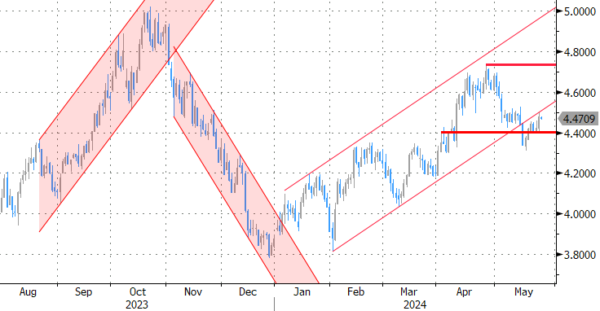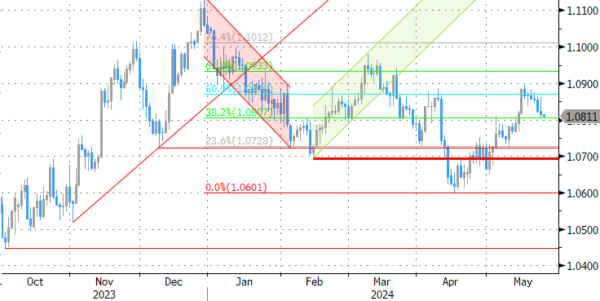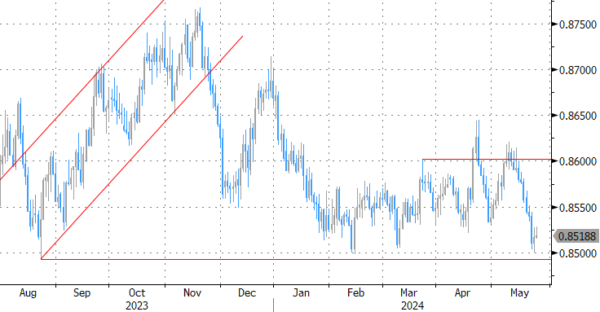Markets
Core bonds fell yesterday with German Bunds marginally underperforming US Treasuries. A solid European May services PMI (unchanged at 53.3) and an improving manufacturing one (47.4 from 45.7) coupled with record-matching Q1 wage negotiations (picking up from 4.5% to 4.7%) hurled German yields between 4.2 and 7.4 bps higher. The front of end of the curve – in swaps as well – rose to new YtD highs. The German 10-yr yield attacked 2.59% resistance and finished just a few bps shy of the April 2024 high. US rates swung 4.3 to 6.7 bps higher with similar front-end underperformance in response to strong country PMIs. Reversing a slowdown over the prior three months, service sector activity (54.8 from 51.3) was the strongest in a year as new orders picked up. Increased manufacturing output and a moderating drag from new orders lifted the headline figure from 50 to 50.9 in May. Sharply rising input prices, especially in manufacturing, led to higher selling prices. PMI owner S&P Global concluded that “rates of inflation for costs and selling prices are now somewhat elevated by pre-pandemic standards in both sectors to suggest that the final mile down to the Fed’s 2% target still seems elusive.” The dollar’s sharp intraday U-turn resulted in the fourth daily loss for EUR/USD this week. The pair finished at 1.0815 after trading as high as 1.086. DXY moved beyond 105. A setback in the UK services PMI offered EUR/GBP (0.8516) some breathing room after testing the critical 0.85 support area. PM Sunak’ surprise announcement of general elections on July 4 already left no marked impact on sterling. The Tories have been trailing the opposition Labour party for a very long time and their defeat seems discounted for now. US stock markets are showing signs of exhaustion with bearish engulfers popping up in the S&P500 and Nasdaq. Both indices were flirting overbought territory in recent days. The upcoming long weekend in the US for Memorial Day on Monday may have served as an excuse to take some chips off the table as well. Against this background we doubt whether US durable goods orders will move markets in a significant way. Fed Waller’s keynote speech on the neutral rate is worth mentioning though. Following yesterday’s jump we don’t expect US rates to show similar vigour ahead of the (long) weekend but the downside for now looks well protected. Closing the week with new YtD highs in European (short-term) rates would be technically important. EUR/USD is testing support at 1.0811. Breaking below would bring the pair back within the downward 2024 trend channel. EUR/GBP jumped towards 0.853 before paring gains after the UK released disastrous retail sales this morning. We nonetheless believe the pair is ready for a gradual recovery within the sideways 0.85-0.87 trading range again. The UK is also headed for an extended weekend (Spring bank holiday on Monday).
News & Views
UK consumer confidence as measured by Growth for Knowledge improved further in May, from -19 to -17, the best level since December 2021 and beating -18 consensus. Details showed personal financial prospects, savings and the general economic outlook all improving whereas willingness to buy big-ticket items declined. The latter reinforces the fact that the cost-of-living crisis is still a day-to-day reality for all of us according the GfK. Client strategy director Staton added though that the latest drop in headline inflation and the prospect of interest-rate cuts in due course suggest that the trend is certainly positive after a long period of stasis. All in all, consumers are clearly sensing that conditions are improving, anticipating further growth in confidence in the months to come.
The pace of national Japanese headline inflation remained unchanged in April at 0.2% M/M. In Y/Y-terms, inflation slowed from 2.7% to 2.5%. The main contributor was a deceleration in processed food prices. The Bank of Japan’s preferred ex fresh food gauge was flat M/M, with the Y/Y-measure extending its disinflationary trend from 2.6% to 2.2%. Services inflation declined by 0.1% M/M with Y/Y growth slowing from 2.1% to 1.7%. Japanese inflation is falling towards the BoJ 2% inflation target but today’s data are unlikely to derail plans to very gradually increase the policy rate with strong wage gains (>5% for large companies) expected to spur spending and inflation.
Graphs
GE 10y yield
ECB President Lagarde clearly hinted at a summer (June) rate cut which has broad backing. EMU disinflation continued in April and brought headline CPI closer to the 2% target. Together with weak growth momentum, this gives backing to deliver a first 25 bps rate cut. A more bumpy inflation path in H2 2024 and the Fed’s higher for longer strategy make follow-up moves difficult. Markets have come to terms with that.
US 10y yield
The Fed in May acknowledged the lack of progress towards the 2% inflation objective, but Fed’s Powell left the door open for rate cuts later this year. Soft US ISM’s and weaker than expected payrolls supported markets’ hope on a first cut post summer, triggering a correction off YTD peak levels. Sticky inflation suggests any rate cut will be a tough balancing act. 4.37% (38% retracement Dec/April) already might prove strong support for the US 10-y yield.
EUR/USD
Economic divergence, a likely desynchronized rate cut cycle with the ECB exceptionally taking the lead and higher than expected US CPI data pushed EUR/USD to the 1.06 area. From there, better EMU data gave the euro some breathing space. The dollar lost further momentum on softer than expected early May US data. Some further consolidation in the 1.07/1.09 are might be on the cards short-term.
EUR/GBP
Debate at the Bank of England is focused at the timing of rate cuts. Most BoE members align with the ECB rather than with Fed view but slower than expected April disinflation and a surprise general election on July 4 complicated matters. A June cut in line with the ECB looks improbable. Sterling extends a recent bull rally. A test of EUR/GBP’s 2024 YtD low (0.8489) is possible. We expect this important support level to hold.















